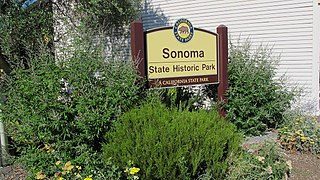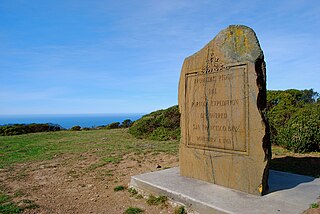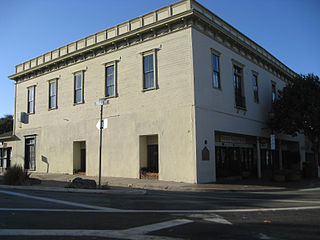
Mission San Antonio de Padua is a Spanish mission established by the Franciscan order in present-day Monterey County, California, near the present-day town of Jolon. Founded on July 14, 1771, it was the third mission founded in Alta California by Father Presidente Junípero Serra. The mission was the first use of fired tile roofing in Upper California. Today the mission is a parish church of the Diocese of Monterey and is no longer active in the mission work which it was set up to provide.

El Camino Real is a 600-mile (965-kilometer) commemorative route connecting the 21 Spanish missions in California, along with a number of sub-missions, four presidios, and three pueblos. Historically associated with a network of royal roads used by inhabitants of New Spain, the modern commemorative route in the U.S. state of California is named after these roads, with its southern terminus at Mission San Diego de Alcalá and its northern terminus at Mission San Francisco Solano in Sonoma, California.

A California Historical Landmark (CHL) is a building, structure, site, or place in the U.S. state of California that has been determined to have statewide historical landmark significance.

Marshall Gold Discovery State Historic Park is a state park of California, United States, marking the discovery of gold by James W. Marshall at Sutter's Mill in 1848, sparking the California Gold Rush. The park grounds include much of the historic town of Coloma, California, which is now considered a ghost town as well as a National Historic Landmark District. The park contains the California Historical Landmarks: a monument to commemorate James Marshall (#143), the actual spot where he first discovered gold in 1848 (#530). Established in 1942, and Coloma Road (#748),. The park now comprises 576 acres (233 ha) in El Dorado County.

Rancho Petaluma Adobe is a historic ranch house in Sonoma County, California. It was built from adobe bricks in 1836 by order of Mariano Guadalupe Vallejo. It was the largest privately owned adobe structure built in California and is the largest example of the Monterey Colonial style of architecture in the United States. A section of the former ranch has been preserved by the Petaluma Adobe State Historic Park and it is both a California Historic Landmark and a National Historic Landmark. The Rancho Petaluma Adobe State Historic Park is located on Adobe Road on the east side of the present-day town of Petaluma, California.

Sonoma State Historic Park is a California State Park located in the center of Sonoma, California. The park consists of six sites: the Mission San Francisco Solano, the Sonoma Barracks, the Blue Wing Inn, La Casa Grande, Lachryma Montis, and the Toscano Hotel.

The San Francisco Bay Discovery Site is a marker commemorating the first recorded European sighting of San Francisco Bay. In 1769, the Portola expedition traveled north by land from San Diego, seeking to establish a base at the Port of Monterey described by Sebastian Vizcaino in 1602. When they reached Monterey, however, they were not sure it was the right place and decided to continue north. The party reached San Pedro Creek on October 31 and camped there for four nights, while scouts led by José Francisco Ortega climbed Sweeney Ridge, where they could see over the ridge toward the east, and so became the first Europeans to see San Francisco Bay on November 1.

San Pasqual Battlefield State Historic Park honors the soldiers who fought in the 1846 Battle of San Pasqual, the bloodiest battle in California during the Mexican–American War. The battle was fought between United States troops under the command of General Stephen Kearny, and the Californio forces under the command of General Andres Pico on December 6, 1846.

Native Daughters of the Golden West is an American non-profit organization for women born in California. The organization focuses on the care and preservation of California history. It is the sister organization to the Native Sons of the Golden West.

The Sonoma Barracks is a two-story, wide-balconied, adobe building facing the central plaza of the City of Sonoma, California. It was built by order of Mariano Guadalupe Vallejo to house the Mexican soldiers that had been transferred from the Presidio of San Francisco in 1835. The Presidio Company and their commander, Vallejo, were also responsible for controlling the Native Americans living on the northern border of Mexican California.

Fort Benson was a Fort built in 1856 in present-day Colton in San Bernardino County, California. The Fort is named for its builder, Jerome Benson. The Fort was abandoned a year after it was built in 1857. Fort Benson was designated a California Historic Landmark (No.617) on September 11, 1957. Jerome Benson, in fear, built the Fort because of land disputes. The fort on his land claim, was made of earthworks and wood. The fort was defended by a brass cannon. The fort was used only one year as about half the Mormons around his land were told to return to Utah during the Mormon War, also call the Utah War. On December 27, 1858, the US Army arrived into San Bernardino. The US Army's Mojave Expedition leader was Colonel William Hoffman. He placed troops in San Bernardino and Cajon Pass to deal with Indians and the land problems. Fort Benson is gone and only a marker is at the spot of the fort.

The Gates of Anaheim are a series of gates in California that mark the historic entrance to Anaheim, California. Four city gates were built: North, East, South, and West. They were designated a California Historic Landmark (No.122) on March 29, 1933.

Sheldon Grist Mill Site, is historical site in Sloughhouse, California in Sacramento County. The site is a California Historical Landmark No. 604 listed on June 2, 1949. The water powered gristmill, was used turn grain into flour, was on Rancho Omochumnes. The gristmill was built by Jared Dixon (Joaquin) Sheldon. Sheldon was grant then five square league of land on Rancho Omochumnes by the First Mexican Republic in 1843 by Mexican Governor Manuel Micheltorena as payment for carpenter work on the Monterey Custom House. Sheldon born on January 8, 1813, in Vermont and travelled to California 1832, working as a carpenter and millwright. Sheldon married Catherine Rhoads, the daughters of Thomas Rhoads in March 1847. Sheldon and his partner, William Daylor, also did some gold mining. Sheldon built a dam on Clark's Bar river on his Sheldon Grant to irrigate the crops on his lands. The dam flooded a California Gold Rush miners' claim. The angry miners' shot Sheldon on July 11, 1851. The conflict with Sheldon and the miners is called the Riot on the Cosumnes. In the conflict Sheldon was not the only one shot. Also Killed was James M. Johnson of Lancaster, Iowa and Edward Cody of Fox River, Illinois. Three were wounded: Calvin Dickerson of Berrien County, Michigan, Emanuel Bush of Des Moines County, Iowa and one unnamed miner. The Sheldon Grant was boarded on the south by the Cosumnes River and north by Deer Creek, 17 miles long between the rivers. The Sheldon Grist Mill was just west of the Sloughhouse Pioneer Cemetery, where Sheldon and his partner William Daylor and are buried. The site today is still mostly farmland.

Los Puertecitos Pass in Ocotillo Wells, California, in San Diego County, is California Historical Landmark No. 635 listed on March 3, 1958. The Los Puertecitos is a desert pass used by the Spanish Commander Juan Bautista de Anza and Father Francisco Garcés expedition of 1775 and 1776. The expedition came through the pass on December 19, 1775. Near the pass on a flats east of the pass the expedition rested and watered its stock of mules, cattle, and horses.

Juan Brown (1799–1859), nickname Juan Flaco, known as the Paul Revere of California, rode from Los Angeles to San Francisco California in four days, 52 hours, in 1846, during the Mexican–American War. Juan "Flaco" Brown was sent by Captain Archibald H. Gillespie at Fort Hill to due the Siege of Los Angeles, started on September 22, 1846. United States Army Troops were trapped in Pueblo de Los Ángeles, Alta California by José María Flores men. Juan "Flaco" Brown took word to Commodore Robert F. Stockton in San Francisco of the serious trouble the Gillespie's troops in Los Angeles were in.

First Presbyterian Church of Benicia was founded on April 15, 1849, at a building in Benicia, California in Solano County, California. The Presbyterian Church of Benicia site is a California Historical Landmark No. 175 listed on March 6, 1935. The First Presbyterian Church of Benicia was the first Protestant church founded in California with a staff pastor. The pastor was Reverend Sylvester Woodbridge Jr., who founded the church in 1849 using a school house. Woodbridge came to California in 1848. First Presbyterian Church built a building that was dedicated on March 9, 1851. Woodbridge was the pastor till 1869, when he moved to San Francisco. The Presbyterian California Gold Rush church ended in 1875. The Church became a One-room school and most of the members moved to the First Congregational Church of Benicia founded in 1865. Later the church-school building became an Episcopal Church. The Episcopal Church soon built a larger church. The 1851 church was remove and the land became Benicia City Park.

Saint Paul's Episcopal Church of Benicia is historical church Building built in 1859 in Benicia, California in Solano County, California. The Saint Paul's Episcopal Church is a California Historical Landmark No. 862 listed on July 20, 1973. Saint Paul's Episcopal Church was designed Lt. Julian McAllister and built by shipwrights of the Pacific Mail Steamship Company. Saint Paul's Episcopal Church is built in the early California Gothic ecclesiastical architecture. The church as dedicated on February 12, 1860, 164 years ago, by the church's first pastor Rev. William Ingraham and is still open. The church was founded on September 24, 1854 170 years ago, by Major F. D. Townsend, with the US Army in the Benicia Sate Capital Building.

Sonoma Valley Woman's Club is a historic woman's clubhouse located in Sonoma, California. It was founded in 1901 by eleven local women led by Martha Stearns. Built in 1916, the club was designed by architect Brainerd Jones from Petaluma and plays a role in the civic development of Sonoma. The Woman's Club was listed on the National Register of Historic Places on January 7, 2015.

The Governor Alvarado House also known as the Alvarado House, is a historic adobe and wood building in Monterey, California, United States. It was built as a lodging house for Juan Bautista Alvarado, the Governor of Alta California from December 20, 1836, to December 20, 1842. On August 8, 1939, the building was officially designated a California Historical Landmark #348. The Governor Alvarado House is part of the Monterey State Historic Park that includes 17 historic buildings in Monterey's old town historic district.





















